LAW 504: Negligence Liabilities of Betapharm Ltd: An ILAC Analysis
VerifiedAdded on 2022/09/22
|7
|1174
|24
Report
AI Summary
This report analyzes the negligence liabilities of Betapharm Ltd concerning the drug THX 1138, following an assignment brief that required the use of the ILAC (Issue, Law, Application, Conclusion) format. The report addresses the potential liabilities of Betapharm Ltd to three individuals: Alice, Bob, and Dan. The issue focuses on whether Betapharm Ltd breached its duty of care. The report outlines the relevant laws of negligence, including the elements of duty of care, breach of duty, and causation, referencing key legal precedents like Donoghue v. Stevenson, Bolton v. Stone, and the Civil Liability Act. The application section examines the specific facts of the case, determining the existence of a duty of care, breach, and causation for each individual. The conclusion finds Betapharm Ltd liable to Alice due to the physical injury caused by the drug, while concluding no liability towards Bob and Dan. The report also considers the defense of volenti non fit injuria in Dan’s case. The assignment provides a clear and structured legal analysis of the given scenario.
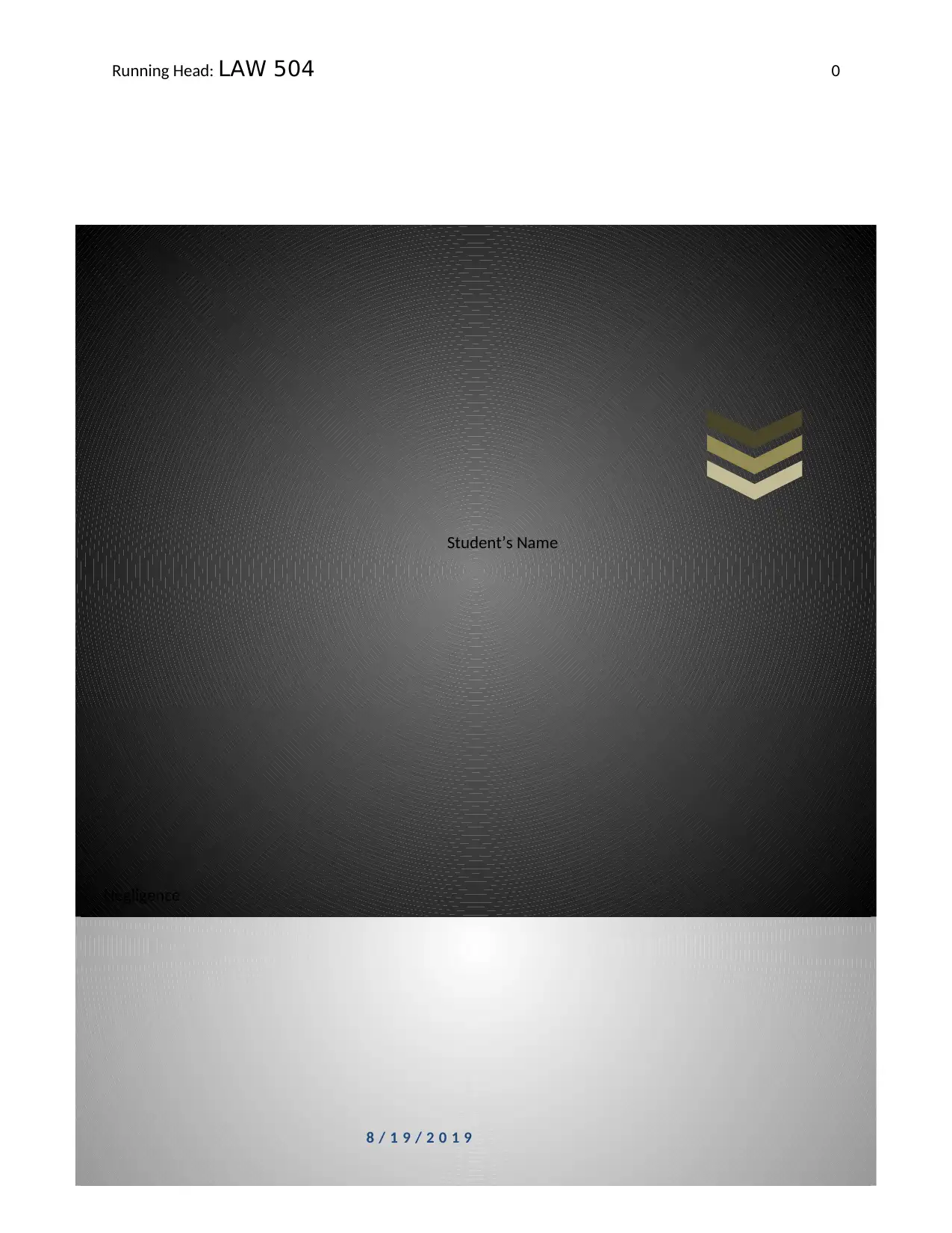
Negligence
Running Head: LAW 504 0
8 / 1 9 / 2 0 1 9
Student’s Name
Running Head: LAW 504 0
8 / 1 9 / 2 0 1 9
Student’s Name
Paraphrase This Document
Need a fresh take? Get an instant paraphrase of this document with our AI Paraphraser
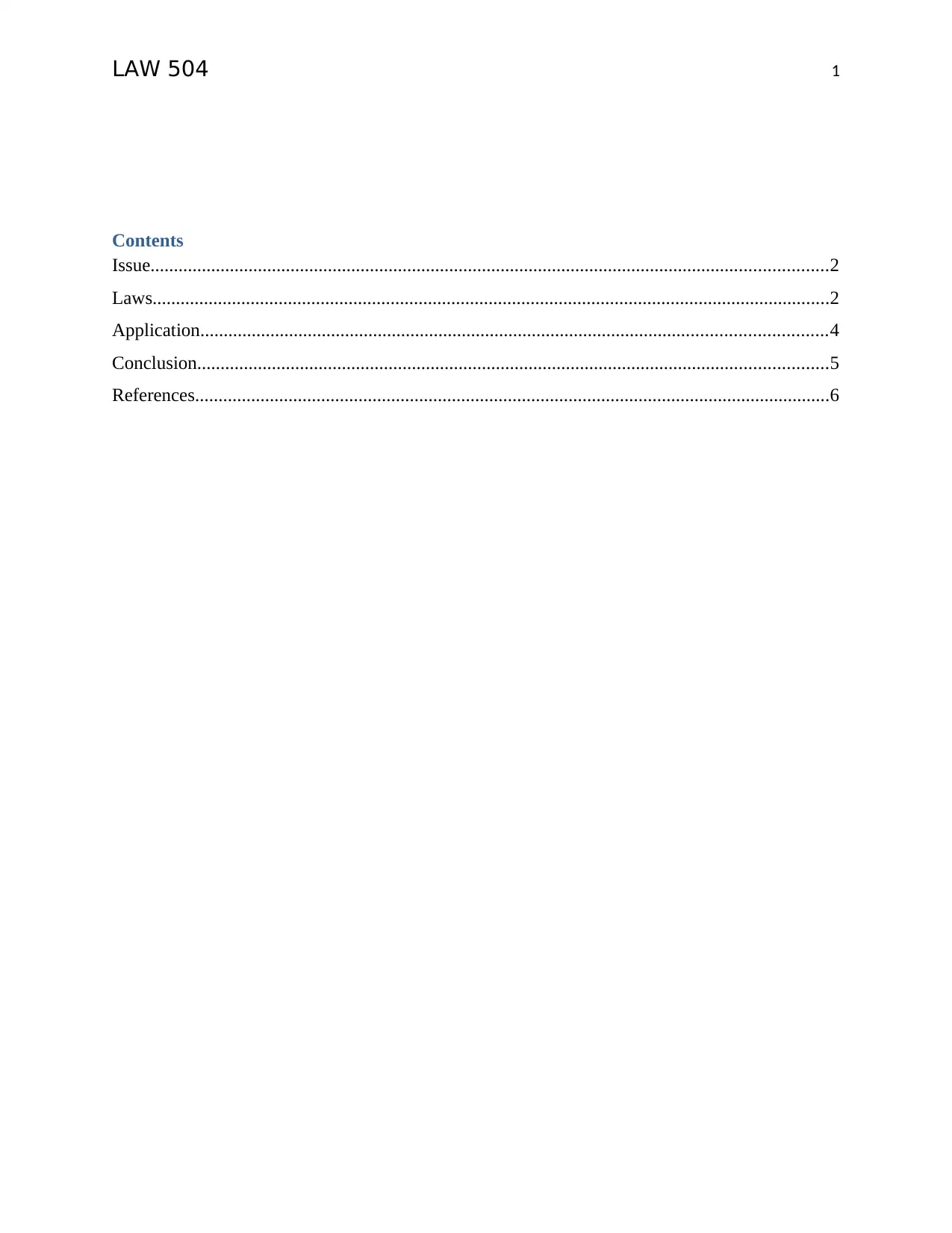
LAW 504 1
Contents
Issue.................................................................................................................................................2
Laws.................................................................................................................................................2
Application......................................................................................................................................4
Conclusion.......................................................................................................................................5
References........................................................................................................................................6
Contents
Issue.................................................................................................................................................2
Laws.................................................................................................................................................2
Application......................................................................................................................................4
Conclusion.......................................................................................................................................5
References........................................................................................................................................6
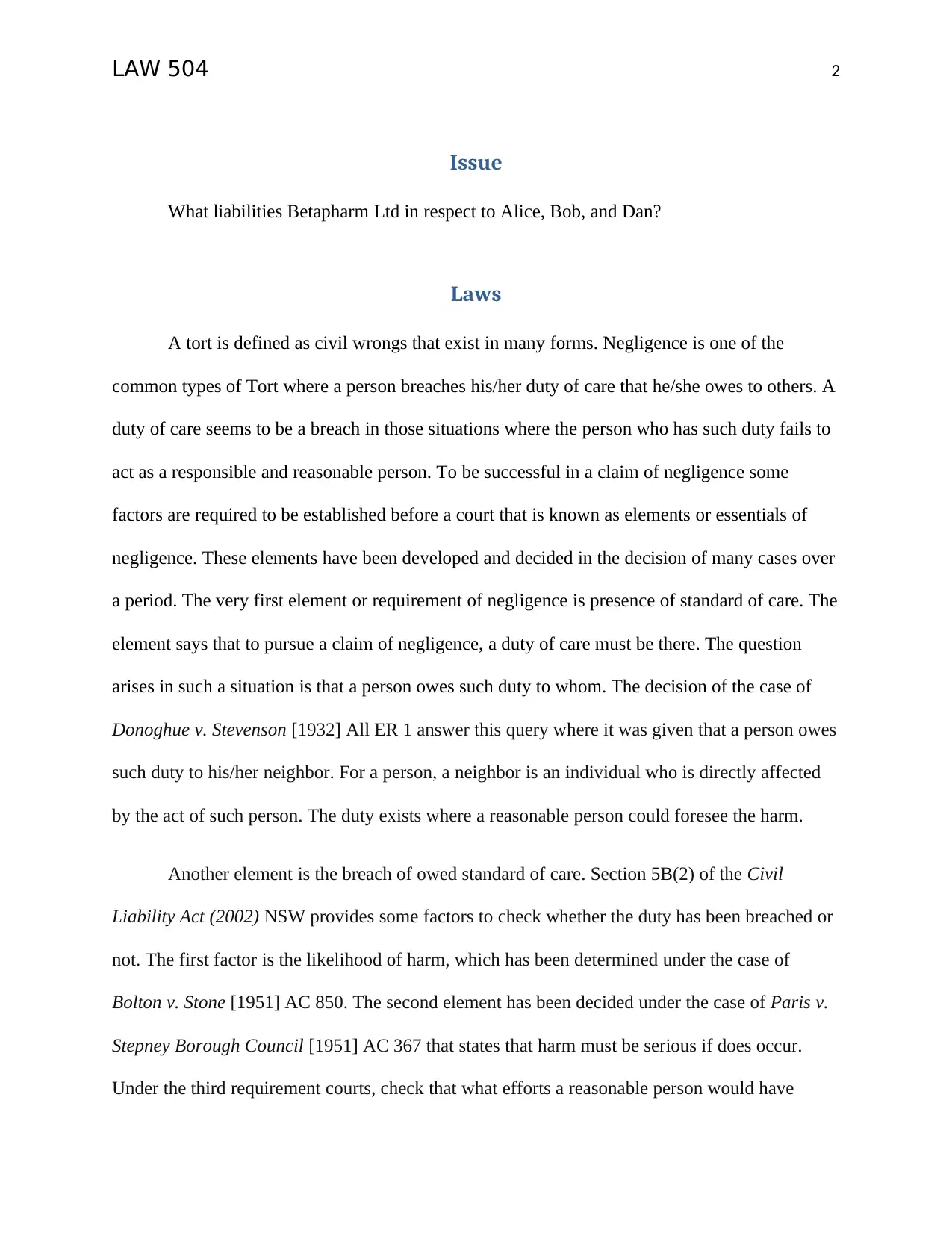
LAW 504 2
Issue
What liabilities Betapharm Ltd in respect to Alice, Bob, and Dan?
Laws
A tort is defined as civil wrongs that exist in many forms. Negligence is one of the
common types of Tort where a person breaches his/her duty of care that he/she owes to others. A
duty of care seems to be a breach in those situations where the person who has such duty fails to
act as a responsible and reasonable person. To be successful in a claim of negligence some
factors are required to be established before a court that is known as elements or essentials of
negligence. These elements have been developed and decided in the decision of many cases over
a period. The very first element or requirement of negligence is presence of standard of care. The
element says that to pursue a claim of negligence, a duty of care must be there. The question
arises in such a situation is that a person owes such duty to whom. The decision of the case of
Donoghue v. Stevenson [1932] All ER 1 answer this query where it was given that a person owes
such duty to his/her neighbor. For a person, a neighbor is an individual who is directly affected
by the act of such person. The duty exists where a reasonable person could foresee the harm.
Another element is the breach of owed standard of care. Section 5B(2) of the Civil
Liability Act (2002) NSW provides some factors to check whether the duty has been breached or
not. The first factor is the likelihood of harm, which has been determined under the case of
Bolton v. Stone [1951] AC 850. The second element has been decided under the case of Paris v.
Stepney Borough Council [1951] AC 367 that states that harm must be serious if does occur.
Under the third requirement courts, check that what efforts a reasonable person would have
Issue
What liabilities Betapharm Ltd in respect to Alice, Bob, and Dan?
Laws
A tort is defined as civil wrongs that exist in many forms. Negligence is one of the
common types of Tort where a person breaches his/her duty of care that he/she owes to others. A
duty of care seems to be a breach in those situations where the person who has such duty fails to
act as a responsible and reasonable person. To be successful in a claim of negligence some
factors are required to be established before a court that is known as elements or essentials of
negligence. These elements have been developed and decided in the decision of many cases over
a period. The very first element or requirement of negligence is presence of standard of care. The
element says that to pursue a claim of negligence, a duty of care must be there. The question
arises in such a situation is that a person owes such duty to whom. The decision of the case of
Donoghue v. Stevenson [1932] All ER 1 answer this query where it was given that a person owes
such duty to his/her neighbor. For a person, a neighbor is an individual who is directly affected
by the act of such person. The duty exists where a reasonable person could foresee the harm.
Another element is the breach of owed standard of care. Section 5B(2) of the Civil
Liability Act (2002) NSW provides some factors to check whether the duty has been breached or
not. The first factor is the likelihood of harm, which has been determined under the case of
Bolton v. Stone [1951] AC 850. The second element has been decided under the case of Paris v.
Stepney Borough Council [1951] AC 367 that states that harm must be serious if does occur.
Under the third requirement courts, check that what efforts a reasonable person would have
⊘ This is a preview!⊘
Do you want full access?
Subscribe today to unlock all pages.

Trusted by 1+ million students worldwide
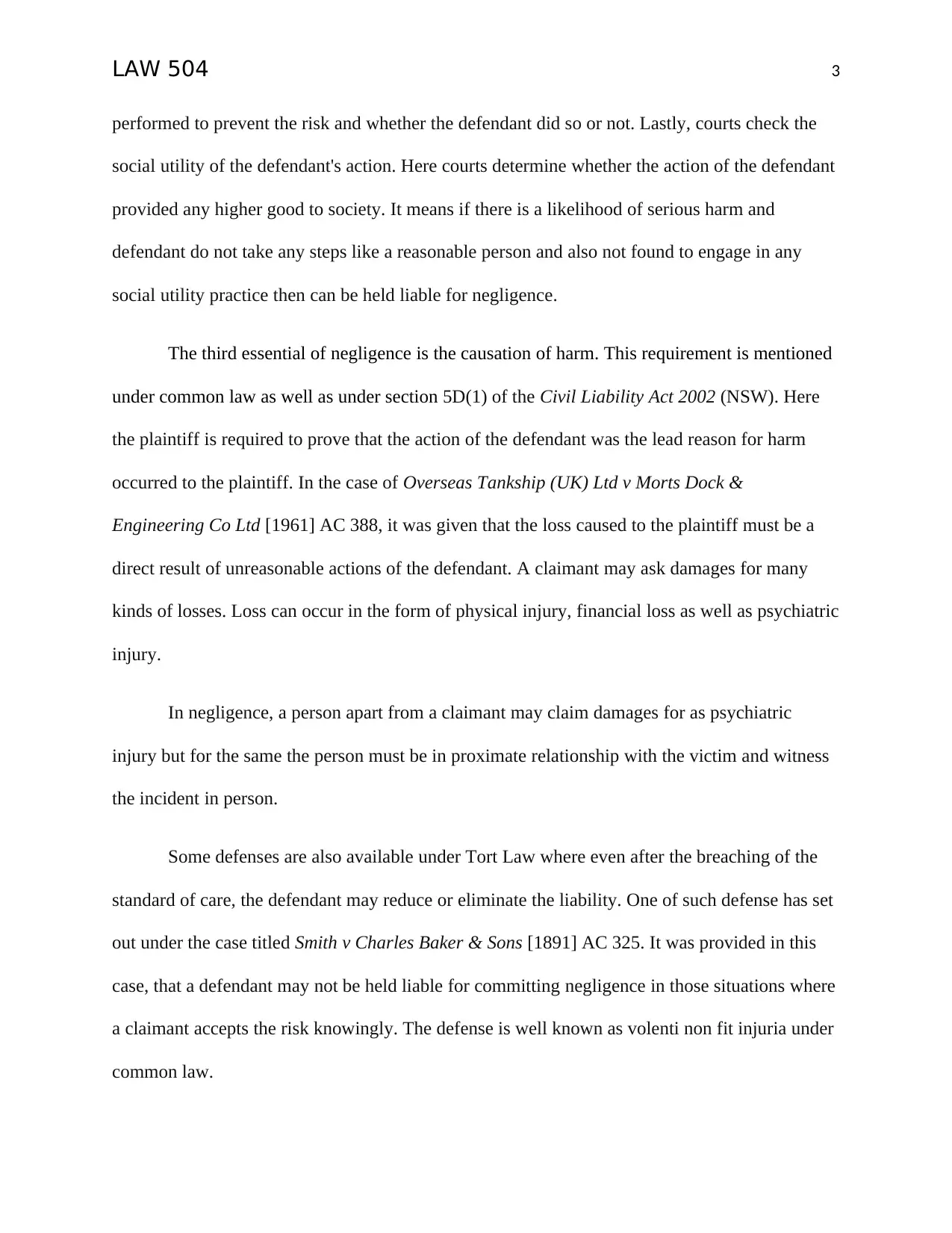
LAW 504 3
performed to prevent the risk and whether the defendant did so or not. Lastly, courts check the
social utility of the defendant's action. Here courts determine whether the action of the defendant
provided any higher good to society. It means if there is a likelihood of serious harm and
defendant do not take any steps like a reasonable person and also not found to engage in any
social utility practice then can be held liable for negligence.
The third essential of negligence is the causation of harm. This requirement is mentioned
under common law as well as under section 5D(1) of the Civil Liability Act 2002 (NSW). Here
the plaintiff is required to prove that the action of the defendant was the lead reason for harm
occurred to the plaintiff. In the case of Overseas Tankship (UK) Ltd v Morts Dock &
Engineering Co Ltd [1961] AC 388, it was given that the loss caused to the plaintiff must be a
direct result of unreasonable actions of the defendant. A claimant may ask damages for many
kinds of losses. Loss can occur in the form of physical injury, financial loss as well as psychiatric
injury.
In negligence, a person apart from a claimant may claim damages for as psychiatric
injury but for the same the person must be in proximate relationship with the victim and witness
the incident in person.
Some defenses are also available under Tort Law where even after the breaching of the
standard of care, the defendant may reduce or eliminate the liability. One of such defense has set
out under the case titled Smith v Charles Baker & Sons [1891] AC 325. It was provided in this
case, that a defendant may not be held liable for committing negligence in those situations where
a claimant accepts the risk knowingly. The defense is well known as volenti non fit injuria under
common law.
performed to prevent the risk and whether the defendant did so or not. Lastly, courts check the
social utility of the defendant's action. Here courts determine whether the action of the defendant
provided any higher good to society. It means if there is a likelihood of serious harm and
defendant do not take any steps like a reasonable person and also not found to engage in any
social utility practice then can be held liable for negligence.
The third essential of negligence is the causation of harm. This requirement is mentioned
under common law as well as under section 5D(1) of the Civil Liability Act 2002 (NSW). Here
the plaintiff is required to prove that the action of the defendant was the lead reason for harm
occurred to the plaintiff. In the case of Overseas Tankship (UK) Ltd v Morts Dock &
Engineering Co Ltd [1961] AC 388, it was given that the loss caused to the plaintiff must be a
direct result of unreasonable actions of the defendant. A claimant may ask damages for many
kinds of losses. Loss can occur in the form of physical injury, financial loss as well as psychiatric
injury.
In negligence, a person apart from a claimant may claim damages for as psychiatric
injury but for the same the person must be in proximate relationship with the victim and witness
the incident in person.
Some defenses are also available under Tort Law where even after the breaching of the
standard of care, the defendant may reduce or eliminate the liability. One of such defense has set
out under the case titled Smith v Charles Baker & Sons [1891] AC 325. It was provided in this
case, that a defendant may not be held liable for committing negligence in those situations where
a claimant accepts the risk knowingly. The defense is well known as volenti non fit injuria under
common law.
Paraphrase This Document
Need a fresh take? Get an instant paraphrase of this document with our AI Paraphraser
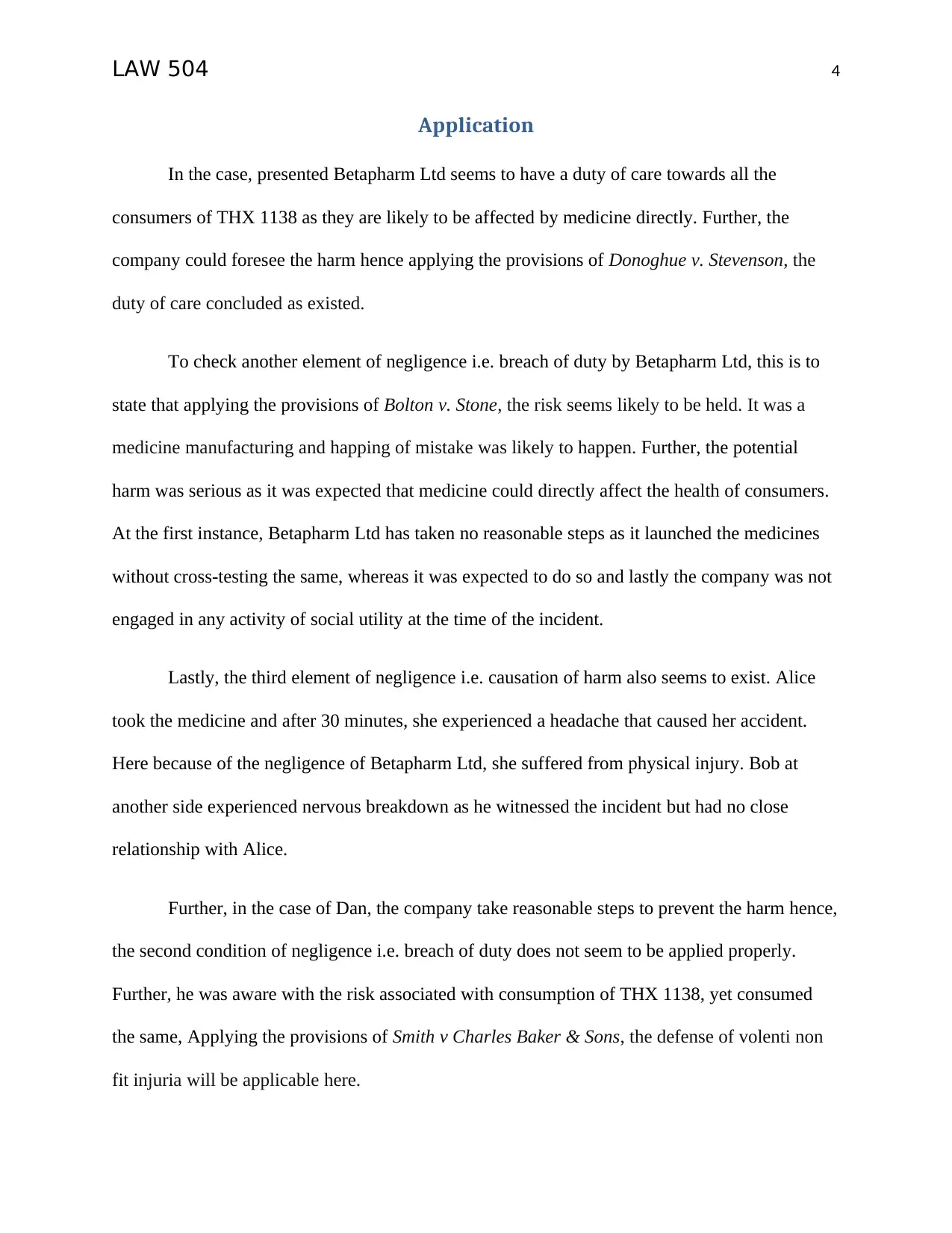
LAW 504 4
Application
In the case, presented Betapharm Ltd seems to have a duty of care towards all the
consumers of THX 1138 as they are likely to be affected by medicine directly. Further, the
company could foresee the harm hence applying the provisions of Donoghue v. Stevenson, the
duty of care concluded as existed.
To check another element of negligence i.e. breach of duty by Betapharm Ltd, this is to
state that applying the provisions of Bolton v. Stone, the risk seems likely to be held. It was a
medicine manufacturing and happing of mistake was likely to happen. Further, the potential
harm was serious as it was expected that medicine could directly affect the health of consumers.
At the first instance, Betapharm Ltd has taken no reasonable steps as it launched the medicines
without cross-testing the same, whereas it was expected to do so and lastly the company was not
engaged in any activity of social utility at the time of the incident.
Lastly, the third element of negligence i.e. causation of harm also seems to exist. Alice
took the medicine and after 30 minutes, she experienced a headache that caused her accident.
Here because of the negligence of Betapharm Ltd, she suffered from physical injury. Bob at
another side experienced nervous breakdown as he witnessed the incident but had no close
relationship with Alice.
Further, in the case of Dan, the company take reasonable steps to prevent the harm hence,
the second condition of negligence i.e. breach of duty does not seem to be applied properly.
Further, he was aware with the risk associated with consumption of THX 1138, yet consumed
the same, Applying the provisions of Smith v Charles Baker & Sons, the defense of volenti non
fit injuria will be applicable here.
Application
In the case, presented Betapharm Ltd seems to have a duty of care towards all the
consumers of THX 1138 as they are likely to be affected by medicine directly. Further, the
company could foresee the harm hence applying the provisions of Donoghue v. Stevenson, the
duty of care concluded as existed.
To check another element of negligence i.e. breach of duty by Betapharm Ltd, this is to
state that applying the provisions of Bolton v. Stone, the risk seems likely to be held. It was a
medicine manufacturing and happing of mistake was likely to happen. Further, the potential
harm was serious as it was expected that medicine could directly affect the health of consumers.
At the first instance, Betapharm Ltd has taken no reasonable steps as it launched the medicines
without cross-testing the same, whereas it was expected to do so and lastly the company was not
engaged in any activity of social utility at the time of the incident.
Lastly, the third element of negligence i.e. causation of harm also seems to exist. Alice
took the medicine and after 30 minutes, she experienced a headache that caused her accident.
Here because of the negligence of Betapharm Ltd, she suffered from physical injury. Bob at
another side experienced nervous breakdown as he witnessed the incident but had no close
relationship with Alice.
Further, in the case of Dan, the company take reasonable steps to prevent the harm hence,
the second condition of negligence i.e. breach of duty does not seem to be applied properly.
Further, he was aware with the risk associated with consumption of THX 1138, yet consumed
the same, Applying the provisions of Smith v Charles Baker & Sons, the defense of volenti non
fit injuria will be applicable here.
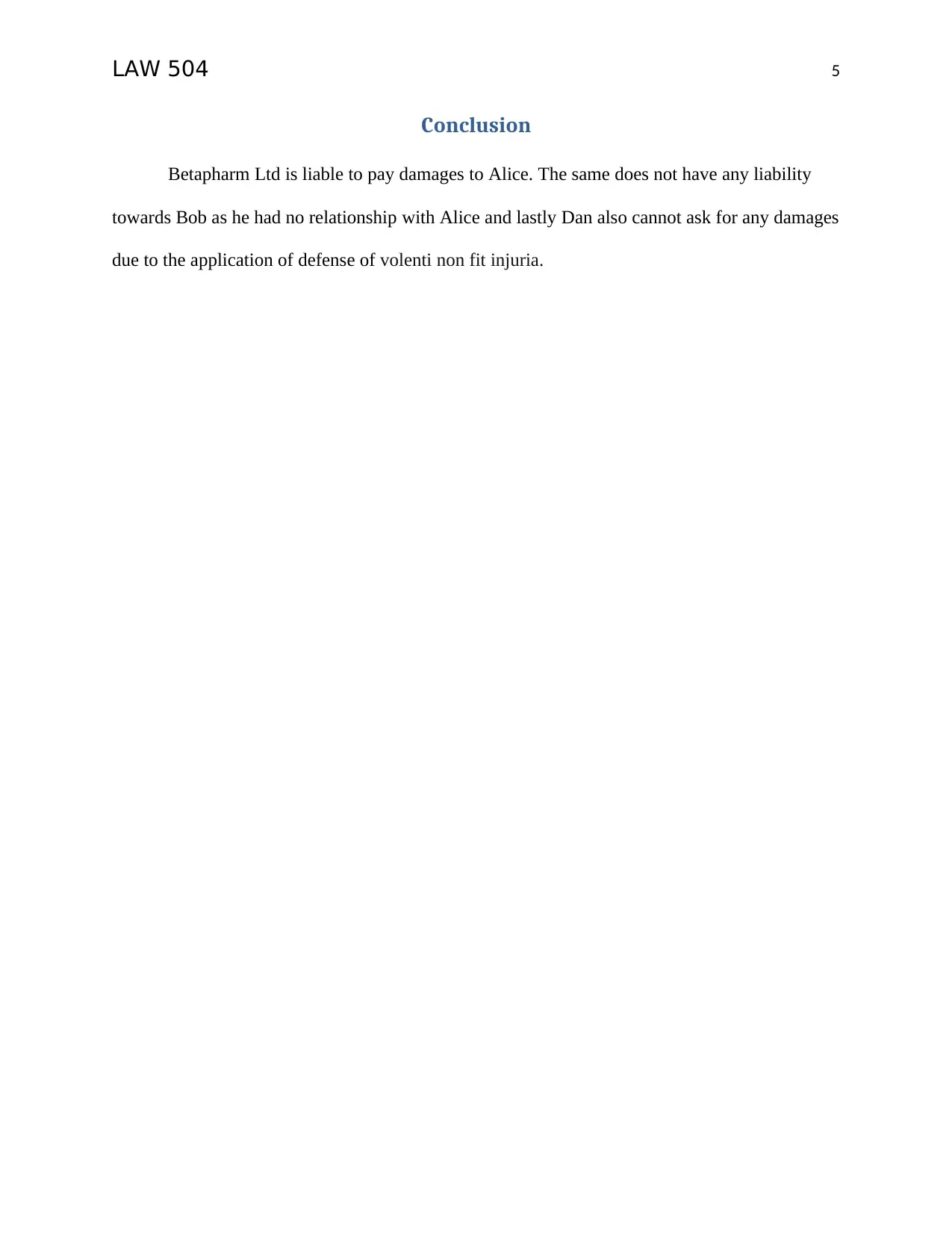
LAW 504 5
Conclusion
Betapharm Ltd is liable to pay damages to Alice. The same does not have any liability
towards Bob as he had no relationship with Alice and lastly Dan also cannot ask for any damages
due to the application of defense of volenti non fit injuria.
Conclusion
Betapharm Ltd is liable to pay damages to Alice. The same does not have any liability
towards Bob as he had no relationship with Alice and lastly Dan also cannot ask for any damages
due to the application of defense of volenti non fit injuria.
⊘ This is a preview!⊘
Do you want full access?
Subscribe today to unlock all pages.

Trusted by 1+ million students worldwide
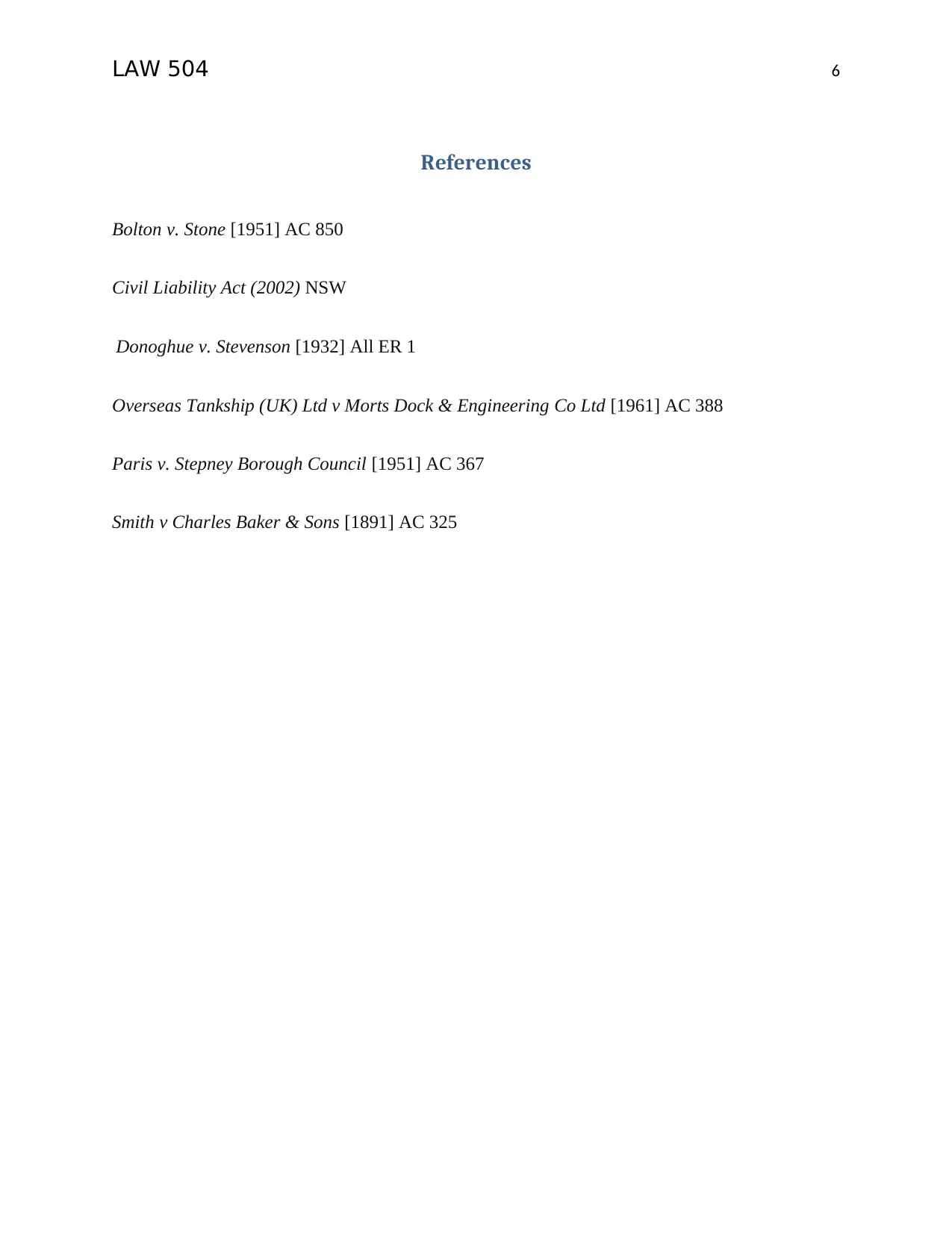
LAW 504 6
References
Bolton v. Stone [1951] AC 850
Civil Liability Act (2002) NSW
Donoghue v. Stevenson [1932] All ER 1
Overseas Tankship (UK) Ltd v Morts Dock & Engineering Co Ltd [1961] AC 388
Paris v. Stepney Borough Council [1951] AC 367
Smith v Charles Baker & Sons [1891] AC 325
References
Bolton v. Stone [1951] AC 850
Civil Liability Act (2002) NSW
Donoghue v. Stevenson [1932] All ER 1
Overseas Tankship (UK) Ltd v Morts Dock & Engineering Co Ltd [1961] AC 388
Paris v. Stepney Borough Council [1951] AC 367
Smith v Charles Baker & Sons [1891] AC 325
1 out of 7
Related Documents
Your All-in-One AI-Powered Toolkit for Academic Success.
+13062052269
info@desklib.com
Available 24*7 on WhatsApp / Email
![[object Object]](/_next/static/media/star-bottom.7253800d.svg)
Unlock your academic potential
Copyright © 2020–2025 A2Z Services. All Rights Reserved. Developed and managed by ZUCOL.





